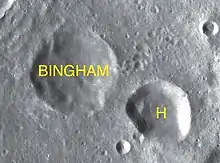Bingham (crater)
Bingham is a small lunar impact crater that is located on the far side of the Moon, relative to the Earth. It is named after the American academic, explorer and politician Hiram Bingham III.[1] It lies just to the southeast of the much larger crater Lobachevskiy, and the northwestern part of the rim of Bingham is partly overlaid by ejecta from Lobachevsky. To the northeast of Bingham is the crater Guyot, and about a crater diameter to the south-southeast is Katchalsky. This is a roughly circular crater formation with a slight outward bulge along the southeastern side.
 Apollo 16 Mapping camera image | |
| Coordinates | 8.02°N 115.05°E |
|---|---|
| Diameter | 34.99 km |
| Depth | Unknown |
| Colongitude | 235° at sunrise |
| Eponym | Hiram Bingham III |
Satellite craters

By convention these features are identified on lunar maps by placing the letter on the side of the crater midpoint that is closest to Bingham.
| Bingham | Latitude | Longitude | Diameter |
|---|---|---|---|
| H | 7.5° N | 116.2° E | 26 km |
In popular culture
Bingham, along with another crater, Viviani, was referenced in the Midsomer Murders season 14 episode 'Dark Secrets'.
References
- "Bingham (crater)". Gazetteer of Planetary Nomenclature. USGS Astrogeology Research Program.
- Andersson, L. E.; Whitaker, E. A. (1982). NASA Catalogue of Lunar Nomenclature. NASA RP-1097.
- Bussey, B.; Spudis, P. (2004). The Clementine Atlas of the Moon. New York: Cambridge University Press. ISBN 978-0-521-81528-4.
- Cocks, Elijah E.; Cocks, Josiah C. (1995). Who's Who on the Moon: A Biographical Dictionary of Lunar Nomenclature. Tudor Publishers. ISBN 978-0-936389-27-1.
- McDowell, Jonathan (July 15, 2007). "Lunar Nomenclature". Jonathan's Space Report. Retrieved 2007-10-24.
- Menzel, D. H.; Minnaert, M.; Levin, B.; Dollfus, A.; Bell, B. (1971). "Report on Lunar Nomenclature by the Working Group of Commission 17 of the IAU". Space Science Reviews. 12 (2): 136–186. Bibcode:1971SSRv...12..136M. doi:10.1007/BF00171763. S2CID 122125855.
- Moore, Patrick (2001). On the Moon. Sterling Publishing Co. ISBN 978-0-304-35469-6.
- Price, Fred W. (1988). The Moon Observer's Handbook. Cambridge University Press. ISBN 978-0-521-33500-3.
- Rükl, Antonín (1990). Atlas of the Moon. Kalmbach Books. ISBN 978-0-913135-17-4.
- Webb, Rev. T. W. (1962). Celestial Objects for Common Telescopes (6th revised ed.). Dover. ISBN 978-0-486-20917-3.
- Whitaker, Ewen A. (1999). Mapping and Naming the Moon. Cambridge University Press. ISBN 978-0-521-62248-6.
- Wlasuk, Peter T. (2000). Observing the Moon. Springer. ISBN 978-1-85233-193-1.
